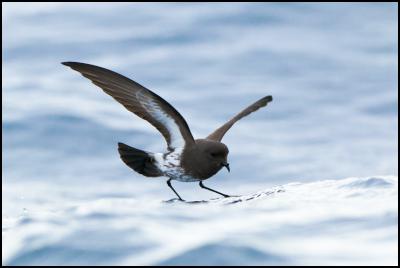First NZ storm petrel egg found by scientists
New Zealand Storm Petrel Project
Media Release
Friday February 28, 2014
First NZ storm petrel egg found by scientists

Click for big version.
New Zealand storm petrel at sea. photo taken by Neil Fitzgerald
Researchers studying the New Zealand storm petrel on Te Hauturu-o-Toi (Little Barrier Island) in the Hauraki Gulf Marine Park are the first scientists to find a NZ storm petrel egg.
New Zealand storm petrels were presumed extinct then rediscovered in 2003, more than a century after the last sighting. In February last year the birds were successfully tracked to breeding sites on Hauturu.
“The egg was found on the same day that a kakapo was found incubating eggs. This tale of two nests is a remarkable and joyful coincidenceand further highlights Hauturu Little Barrier’s role as New Zealand’s premier nature reserve,” says Warren Gibb, chairman of the Hauturu Little Barrier Island Supporters Trust, who, with two local Forest & Bird branches, funded this year’s research.
NZ storm petrel project scientists took the opportunity when the female was off the nest to check the egg was fertile and record data.
“It was exciting to see the egg of a bird once thought to be extinct,” says Graeme Taylor, Department of Conservation (DOC) Principal Science Advisor leading the team. “Measuring a mere 31mm X 23mm, the egg is white with a fine dusting of pink spots concentrated at one end.”
“The fact it has taken until 2014 for scientists to observe one of these tiny eggs reflects how much we still don’t know about New Zealand’s natural environment and particularly for marine species,” says Mr Taylor.
The NZ storm petrel team, also involving Chris Gaskin, Dr Matt Rayner and Alan Tennyson, expect the egg to hatch in early April. Remote cameras set up at known burrows have detected birds coming and going at night.
The project has been supported by DOC with both fieldwork and the logistics of getting gear and personnel to the challenging location of Hauturu/ Little Barrier.
Ngati Manuhiri, mana whenua of Hauturu/Little Barrier are kaitiaki (guardians) of all the taonga on the island and its surroundings, including the translocations of any other taonga coming onto Hauturu such as the kakapo. Ngati Manuhiri fully support any ongoing research and monitoring programmes that deliver outcomes that complement their cultural values and aspirations. Ngati Manuhiri are delighted with these latest developments.
New Zealand Storm Petrel fact
file
• The New
Zealand storm petrel is a sparrow-sized seabird.
•
They spend most of their lives at sea,
coming ashore only to breed.
• They
breed in burrows, are nocturnal when flying to and from
their nest sites.
• They lay only
one egg, which they incubate for over a month.
•
The NZ storm petrel was described from
three specimens. One is in the British Natural History
Museum, Tring, a bird was found on a ship “off Banks
Peninsula, New Zealand”. The ship had travelled from the
Hauraki Gulf. The two specimens in Museum National
d’Histoire Naturelle, Paris were collected off East Cape,
North Island during the first cruise of the French corvette
Astrolabe on 8 February 1827.
• NZ
storm petrels were presumed extinct, then rediscovered in
2003, more than a century after the last sighting. But their
breeding site—the focus of conservation efforts for any
seabird—remained a mystery.
• In
the nine years following rediscovery exploration by
community groups, amateur and professional ornithologists
and scientists has accumulated evidence of presence at sea,
yet failed to reveal the breeding grounds of this critically
endangered species.
• In 2013
members of the NZ storm petrel working group was successful
in locating breeding sites for NZ storm petrel on Te
Hauturu-o-Toi (Little Barrier Island).
•
In the months following the discovery
(March to July 2013) the team was able to monitor a handful
of NZ storm petrel nests.
• This
nesting season, starting in October 2013, remote cameras and
sound recorders have been deployed at the four known nesting
burrows for the species. The devices will remain in place
until July this year. The cameras are triggered by something
moving in front of them and the recorders are set to run for
six hours at
night.
ENDS


 BusinessNZ Energy Council: Forging International Partnerships In Energy
BusinessNZ Energy Council: Forging International Partnerships In Energy Hugh Grant: Empowering Financial Insights With A News API
Hugh Grant: Empowering Financial Insights With A News API Nathan Cooper, The Conversation: Unambitious And Undermined - Why NZ’s Latest Climate Pledge Lacks The Crucial ‘Good Faith’ Factor
Nathan Cooper, The Conversation: Unambitious And Undermined - Why NZ’s Latest Climate Pledge Lacks The Crucial ‘Good Faith’ Factor KiwiRail: Remutaka Tunnel Renewal Complete, Trains Back In Service Monday Morning
KiwiRail: Remutaka Tunnel Renewal Complete, Trains Back In Service Monday Morning Cawthron Institute: Independent Science Could Break Stalemates In Global Plastics Treaty Negotiations
Cawthron Institute: Independent Science Could Break Stalemates In Global Plastics Treaty Negotiations KiwiRail: Great Journeys New Zealand Brings The ‘WOW’ Factor With VIP Packages
KiwiRail: Great Journeys New Zealand Brings The ‘WOW’ Factor With VIP Packages



